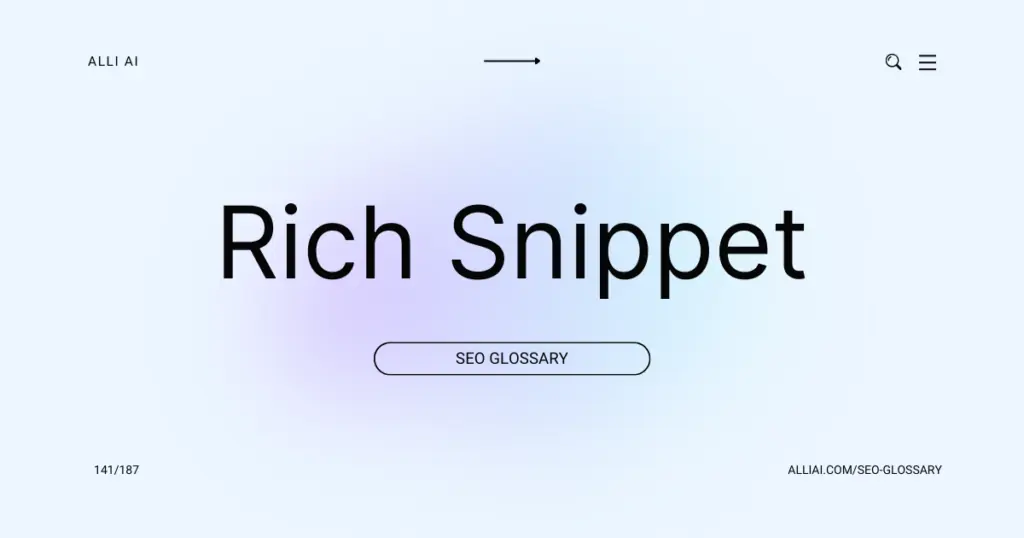What Does Rich Snippet Mean?
A rich snippet is a type of search result on Google that shows extra information along with the usual title, URL, and description. This additional information might include ratings, images, author details, or prices, which helps users understand more about the page before clicking on it. Rich snippets are created using structured data markup added to the HTML of a webpage to provide search engines with more detailed information about the page’s content.
Where Does Rich Snippet Fit Into The Broader SEO Landscape?
Rich Snippets are structured data markup that site operators can add to their existing HTML, which in turn allows search engines to better understand what information is contained on each web page. They appear as special enhancements to search results, such as stars for reviews, prices for products, or images for recipes, providing more detailed information directly in the search results.
In the SEO landscape, Rich Snippets are crucial because they can significantly improve the attractiveness of the search result, potentially increasing click-through rates (CTR). They provide users with a quick snapshot of what the page contains, helping the decision-making process right from the search results, and can lead to a higher conversion rate.
Search engines favor web pages that provide a better user experience and accurately structured data; therefore, sites using Rich Snippets might experience better rankings. They also contribute to semantic SEO, which is about meaning and context, helping search engines interpret the content of your pages more effectively and serve your content to the right audience. Rich Snippets directly impact how content is understood and displayed, which can affect search visibility and user interaction rates.
Real Life Analogies or Metaphors to Explain Rich Snippet
Imagine a library index card that not only tells you where the book is located but also includes a brief synopsis of the plot, the main characters, and the book’s rating according to readers. Rich Snippets serve a similar purpose; they enhance the basic search result with additional, focused information that helps users understand what’s on the web page before they click on it.
Think of a Rich Snippet in search results like a movie trailer, offering a preview of what you can expect on the webpage. Just as a trailer highlights key scenes and actors to entice an audience, a Rich Snippet displays important elements such as star ratings, product prices, or recipe ingredients to attract more informed clicks from searchers.
How the Rich Snippet Functions or is Implemented?
1. Structured Data Markup: Website owners add structured data markup to their HTML. This helps search engines understand the content of the page and its components. Common formats include JSON-LD, Microdata, and RDFa.
2. Types of Data Schema: The data schema dictates what type of information is being communicated. Using vocabularies like Schema.org, webmasters detail aspects like product reviews, recipes, or event times, enabling rich snippet creation.
3. Testing the Markup: Tools like Google’s Rich Results Test are used to validate the structured data and check for errors. This ensures the markup is correctly implemented and readable by search engines.
4. Search Engine Crawling: Search engines crawl the website, parse the structured data, and index the information. This process involves bots analyzing the structured data integrated into the site’s HTML.
5. Rich Snippet Display in SERPs: If the structured data is implemented correctly, search engines may display rich snippets in the search results. The display can include additional information like star ratings, images, or other relevant data.
6. Monitoring and Maintenance: Regular monitoring using tools such as Google Search Console is necessary to check the performance and appearance of the rich snippets and to address any issues highlighted by these tools. Adjustments might be required in response to changes in search engine algorithms or structured data guidelines.
Impact Rich Snippet has on SEO
Rich Snippets enhance a website’s SEO performance by providing search engines with more specific metadata about the content, which can be directly displayed in search results. This additional information often leads to higher click-through rates because users can quickly see more relevant data, making it more likely that they’ll find what they’re looking for. This can lead to increased engagement, potentially lowering bounce rates and increasing time on site. Search engines, in turn, may reward these behavioral signals with higher rankings. Rich Snippets also improve user experience by presenting information in a more useful and visually appealing way, helping users make informed decisions directly from the search results page.
SEO Best Practices For Rich Snippet
1. Identify the type of Rich Snippet you want to target (e.g., Product, Recipe, Review, FAQ, etc.).
2. Ensure your website’s content is high-quality, relevant, and provides value specific to the Rich Snippet type.
3. Use Schema.org to find the appropriate markup for your content type.
4. Implement the structured data markup in the HTML of your webpage.
5. Test the structured data using Google’s Rich Results Test tool to ensure it is implemented correctly.
6. Optimize the page content around the structured data with relevant keywords and high-quality information.
7. Include clear, descriptive titles and meta descriptions that incorporate main keywords naturally.
8. Make sure images and videos used are high-quality and include optimized file names and alt text relevant to the content of the rich snippet.
9. Submit the URL of the webpage to Google via Google Search Console to encourage faster indexing.
10. Monitor the performance in Google Search Console and adjust the content or structured data as necessary based on the results.
Common Mistakes To Avoid
1. Misusing structured data: Incorrectly marking up content not visible to users can lead to penalties. Ensure visible content matches structured data.
2. Overusing structured data: Avoid marking up irrelevant or unnecessary content which can be seen as spammy. Stick strictly to marking up relevant and genuine content.
3. Implementing outdated schema: Use the most current schema.org practices and regularly check for updates. Outdated schema can lead to rich snippet errors and decrease the chances of them showing up correctly.
4. Non-compliance with Google’s guidelines: Non-compliance can lead to rich snippets not being displayed and potential manual actions. Ensure compliance with Google’s Structured Data General Guidelines.
5. Assuming immediate results: It can take time for rich snippets to appear in search results; patience is required. Continue optimizing and updating content while waiting for Google to crawl and index the changes.
6. Incorrect syntax in structured data: Errors in JSON-LD, Microdata, or RDFa syntax can prevent rich snippets from appearing. Validate structured data using Google’s Structured Data Testing Tool.
7. Using only one type of structured data: Diversify the types of structured data used. Utilize reviews, recipes, events, and other relevant schemas to enhance visibility in various SERP features.
8. Neglecting maintenance after setup: Regularly review and update structured data to handle changes in guidelines or website content. Monitor the performance and validate structured data periodically to maintain visibility in search results.
9. Focusing solely on rich snippets for SEO: Rich snippets are only one part of SEO and not a silver bullet. Maintain a balanced approach focusing on content quality, user experience, backlinks, and other SEO fundamentals.






